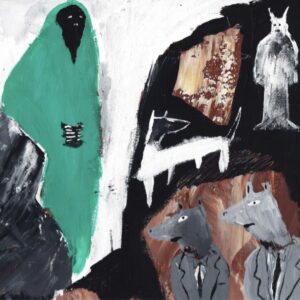
The Cut Is Real: Fauxcils’ Coldwave Elegy
The Sudbury duo’s latest album, Tears of Paint, is a coldwave ritual that pulses through synths and sculpture alike.
by Cam Delisle
Fauxcils’ Tears of Paint is a somber excavation of memory, a record that moves through shadowed spaces, finding beauty in what’s left behind. The Sudbury-born coldwave duo composed of Jenn Herd and Dunstan Topp exhume past selves, simultaneously lacing grief into drum machines and layering heartbreak with ceramic lacquer.
Album opener “Silent Hands” glides in on synth shimmer, but beneath the gloss lies barbed wire. Herd’s voice arrives bruised but defiant, navigating Topp’s precise, jagged arrangements like a scalpel through silk. With sonic nods to acts like Kraftwerk, Cold Cave, and the Cocteau Twins, the duo draws blood from the synthetic—channeling cold love, sequined rituals, and androgynous ruin into something lush and deeply cinematic.
The video for “Silent Hands” marks a stark collaboration with queer Sudbury filmmaker Bosmo, whose upcoming debut feature Dark Frequencies expands the Fauxcils universe into full-blown cinematic folklore. Herd stars as Eva, a spectral figure tethered to sound’s deadly grip, while two tracks from Tears of Paint haunt the film’s undoing.
More than musicians, Herd and Topp are aesthetic archaeologists—screen printers, ceramicists, installation artists—constructing ornate live sets where sound meets sculpture in spaces that dissolve borders. Fauxcils live shows are ceremonies, burning through artifice to find what breathes underneath. Tears of Paint is a testimony to this, fossilizing modern textures in ageless forms. The tears may be fake, but the cut is real.





